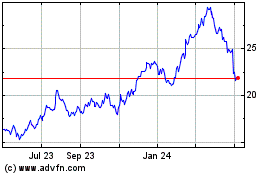Jeep Maker Stellantis Needs Some Tech Star Dust -- Heard on the Street
March 03 2021 - 7:57AM
Dow Jones News
By Stephen Wilmot
Stellantis, the merged company resulting from the combination of
Fiat Chrysler and Peugeot owner PSA, is starting its journey on a
strong financial footing. With the car industry and stock market
gripped by technology fever, though, that isn't enough.
Fiat Chrysler and PSA both reported their last numbers as
stand-alone entities Wednesday. PSA, whose chief executive, Carlos
Tavares, has taken the reins of Stellantis, passed the financial
test posed by the pandemic with flying colors, including record
second-half margins. On a combined basis, Stellantis, which owns
brands ranging from Jeep and RAM to Citroën and Maserati, made an
operating margin of 5.3% last year, behind General Motors but ahead
of Ford.
Stock analysts understandably like the Stellantis story. The
company expects to achieve more than EUR5 billion in savings
through the merger, which would increase operating profits by
roughly 70% from the 2020 level over the coming years. The plan is
plausible, based on greater purchasing muscle with suppliers,
sharing research-and-development costs and bringing new vehicles
onto combined production platforms. None of this growth is factored
into the share price, which trades at a discount to both GM and
Ford on most measures.
But the reality is that investors these days are more interested
in growth driven by new technology than old-school industrial
consolidation. Electric vehicles, self-driving features and vehicle
web connections present as many challenges as opportunities for
even the largest car makers. And unlike companies such as GM,
Hyundai and Volkswagen, Stellantis hasn't yet articulated much of a
technology strategy.
When the company unveiled its new management structure in
January, only one job remained unfilled: chief technology officer.
Given that Mr. Tavares had two sets of top executives to pick from,
the gap suggests Stellantis needs something that neither Fiat
Chrysler nor PSA could provide. Neither company was a leader in
electric-vehicle technology, the foundation for other digital
technologies that will transform the car this decade.
The company committed to a software push Wednesday. This makes
sense, but leaves big questions unanswered. For example, will Mr.
Tavares expand Fiat Chrysler's existing deal with Alphabet's Waymo
for driverless cars into a more comprehensive technology
partnership? Alphabet's Google has been making inroads into
infotainment software with other car makers, including Ford and
GM.
Stellantis is promising a capital markets day late this year or
early next. Along with a plan for China -- the glaring gap in an
otherwise nicely balanced portfolio -- comprehensive responses to
the challenges raised by the car's digitization are the priority.
Until a clearer technology road map emerges, it is hard to see
Stellantis exciting investors about its future in the way its
Detroit peers have lately.
Write to Stephen Wilmot at stephen.wilmot@wsj.com
(END) Dow Jones Newswires
March 03, 2021 07:42 ET (12:42 GMT)
Copyright (c) 2021 Dow Jones & Company, Inc.
Stellantis NV (NYSE:STLA)
Historical Stock Chart
From Mar 2024 to Apr 2024

Stellantis NV (NYSE:STLA)
Historical Stock Chart
From Apr 2023 to Apr 2024
